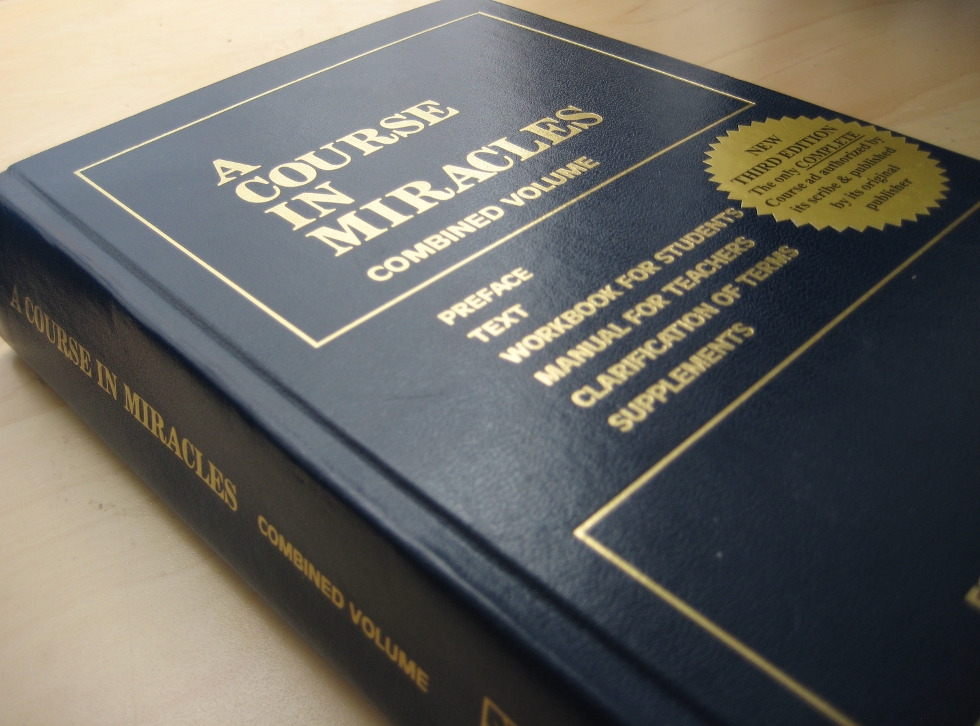The hardcover third edition of A Course in Miracles is bound in navy blue rexine with embossed gold lettering. No author is listed on the front cover or the spine, no compilers, no editors. Instead, under the title are simply listed the contents that make up the Combined Volume—Preface, Text, Workbook for Students, Manual for Teachers, Clarification of Terms and Supplements—and centered at the bottom of the cover, the publisher: the Foundation for Inner Peace. This text, ‘scribed’ by Columbia psychologist Helen Schucman from a channeled inner voice that she attributed to Jesus and published in 1975, resembles nothing so much as a combination of college textbook and Gideon’s Bible, works whose authority is often materially inscribed in their packaging and presentation: leather binding, pages with gold trim, distinctive typography. A yellow sticker is affixed to the front proclaiming this volume as “The only COMPLETE Course ad authorized by its scribe & published by its original publisher.”
But there are other versions of A Course in Miracles: an ‘urtext’ that consists mostly of unedited transcriptions of the divine messages dictated to Schucman, a version of the Course given to the son of Edgar Cayce and deposited in the archives of the Association for Research and Enlightenment, and another, curious version typed and bound in six black thesis binders that was photocopied and circulated in the summer of 1975. This latter version was described in testimony given by co-founder of the Foundation for Inner Peace Judith Skutch Whitson during a case involving copyright infringement on the Course. Skutch Whitson stated that she permitted the xeroxing, “and it seemed very right that people would pass it along, copy it over and copy it over, until finally people’s copies were getting so light that they couldn’t see them anymore.” This promiscuous sharing did seem appropriate for a book that encouraged its readers to experience the plenary nature of existence by giving in the name of the Holy Spirit, by recognizing that, “to spirit getting is meaningless and giving is all,” and that in giving, “all of it is still yours although all of it has been given away.” This expansive and emphatically optimistic understanding of the world is a guiding idea throughout the text, underpinning a spiritual process by which the individual ego is overcome and a complete and fulfilling union with God can be accomplished.
This unofficial photocopied version was circulated before publication as a means to generate interest in a project that had theretofore been kept secret by Schucman and her co-editor William Thetford. On a trip to San Francisco, Skutch Whitson put copies in the hands of a number of people interested in new methods and modes of spiritual practice, including Dr. Edgar Mitchell, founder of the Institute of Noetic Sciences, researchers at the Stanford Research Institute who were working on parapsychological research and the limits of human potentiality, and others across the Bay area. These figures represented nodes in a distributed network of spiritual practitioners, people who could potentially turn A Course in Miracles from a tentative experiment in channeled authorship into a canonical text of contemporary spirituality.
Separated by roughly thirty years, these two contrasting versions of A Course in Miracles—one professionally bound, elegant in design, authenticated by the original publisher and the other incomplete, passed from hand-to-hand, repeatedly copied—indicate two alternate visions of spirituality and the nature of contemporary religious organization. The first vouchsafes its religious legitimacy through rigorously controlled and highly centralized publication practices; the other generates its own organic authority by circulating in a non-centralized and informal network of readers, its movement constituting the very relationships that make up an interconnected spiritual community. The tension between these two visions—a tension between dissemination and control—has played out in the recent history of A Course in Miracles. Indeed, copyright litigation over different versions of the text has not only circumscribed the horizon of spiritual practices but also shaped the contours of the communities in which those practices take place.
Page 1 of 3 | Next page
